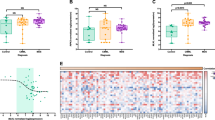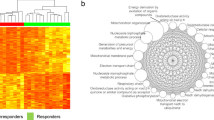Abstract
In vitro studies suggest that haploinsufficiency is involved in the pathogenesis of myelodysplastic syndromes (MDS). In patients with del5q cytogenetic abnormality, RPS-14 and microRNAs (miRNAs) play a major role. In a multicenter phase II single-arm trial with lenalidomide in anemic primary del5q MDS patients with low- or int-1 risk IPSS, biological changes from baseline were investigated. Gene expression profiling of selected genes was performed (TaqMan® Low Density Array Fluidic card, Applied Biosystems PRISM® 7900HT) and normalized against the expression of the 18S housekeeping gene from a pool of healthy subjects. Thirty-two patients were evaluated at baseline and after 3 and 6 months of treatment. RPS-14, miR-145, and miR-146 were downregulated at baseline and significantly increased during treatment. Nuclear factor kappa B, IL-6, interferon regulatory factor-1, IFNγ-R2, IL-2, and many genes in the apoptotic pathways (TNF, IL-1B, and IL-10) were upregulated at baseline and significantly downregulated during lenalidomide treatment, while forkhead box P3, FAS, IFNγ, IL-12A, and IL-12B were downregulated at baseline and progressively upregulated during treatment. The crucial role of aberrant immunological pathways and haploinsufficiency in the pathogenesis of del5q MDS is confirmed in the present patient setting. Our results indicate that lenalidomide may act through defined immunological pathways in this condition.


Similar content being viewed by others
References
Vardiman JW, Thiele J, Arber DA, Brunning RD, Borowitz MJ, Porwit A, Harris NL, Le Beau MM, Hellström-Lindberg E, Tefferi A, Bloomfield CD (2009) The 2008 revision of the World Health Organization (WHO) classification of myeloid neoplasms and acute leukemia: rationale and important changes. Blood 114:937–951
Garcia-Manero G (2011) Myelodysplastic syndromes: 2011 update on diagnosis, risk-stratification, and management. Am J Hematol 86:490–498
Allampallam K, Shetty V, Mundle S, Dutt D, Kravitz H, Reddy PL, Alvi S, Galili N, Saberwal GS, Anthwal S, Shaikh MW, York A, Raza A (2002) Biological significance of proliferation, apoptosis, cytokines, and monocyte/macrophage cells in bone marrow biopsies of 145 patients with myelodysplastic syndrome. Int J Hematol 75:289–297
Kitagawa M, Kurata M, Yamamoto K, Abe S, Suzuki S, Umeda S (2011) Molecular pathology of myelodysplastic syndromes: biology of medullary stromal and hematopoietic cells. Mol Med Rep 4:591–596
Warlick ED, Miller JS (2011) Myelodysplastic syndromes: the role of the immune system in pathogenesis. Leuk Lymphoma 52:2045–2049
Stirewalt DL, Mhyre AJ, Marcondes M, Pogosova-Agadjanyan E, Abbasi N, Radich JP, Deeg HJ (2008) Tumour necrosis factor-induced gene expression in human marrow stroma: clues to the pathophysiology of MDS? Br J Haematol 140:444–453
Haase D, Germing U, Schanz J, Pfeilstöcker M, Nösslinger T, Hildebrandt B, Kundgen A, Lübbert M, Kunzmann R, Giagounidis AA, Aul C, Trümper L, Krieger O, Stauder R, Müller TH, Wimazal F, Valent P, Fonatsch C, Steidl C (2007) New insights into the prognostic impact of the karyotype in MDS and correlation with subtypes: evidence from a core dataset of 2124 patients. Blood 110:4385–4395
Van den Berghe H, Cassiman JJ, David G, Fryns JP, Michaux JL, Sokal G (1974) Distinct haematological disorder with deletion of long arm of no. 5 chromosome. Nature 251:437–438
Padron E, Komrokji R, List AF (2011) The 5q− syndrome: biology and treatment. Curr Treat Options Oncol 12:354–368
List A, Dewald G, Bennett J, Giagounidis A, Raza A, Feldman E, Powell B, Greenberg P, Thomas D, Stone R, Reeder C, Wride K, Patin J, Schmidt M, Zeldis J, Knight R (2006) Lenalidomide in the myelodysplastic syndrome with chromosome 5q deletion. N Engl J Med 355:1456–1465
Le Bras F, Sebert M, Kelaidi C, Lamy T, Dreyfus F, Delaunay J, Banos A, Blanc M, Vey N, Schmidt A, Visanica S, Eclache V, Turlure P, Beyne-Rauzy O, Guerci A, Delmer A, de Botton S, Rea D, Fenaux P, Adès L (2011) Treatment by lenalidomide in lower risk myelodysplastic syndrome with 5q deletion-The GFM experience. Leuk Res 35:1444–1448
Fenaux P, Giagounidis A, Selleslag D, Beyne-Rauzy O, Mufti G, Mittelman M, Muus P, Te Boekhorst P, Sanz G, Del Cañizo C, Guerci-Bresler A, Nilsson L, Platzbecker U, Lübbert M, Quesnel B, Cazzola M, Ganser A, Bowen D, Schlegelberger B, Aul C, Knight R, Francis J, Fu T, Hellström-Lindberg E (2011) A randomized phase 3 study of lenalidomide versus placebo in RBC transfusion-dependent patients with low-/intermediate-1-risk myelodysplastic syndromes with del5q. Blood 118:3765–3776
Jaju RJ, Boultwood J, Oliver FJ, Kostrzewa M, Fidler C, Parker N, McPherson JD, Morris SW, Müller U, Wainscoat JS, Kearney L (1998) Molecular cytogenetic delineation of the critical deleted region in the 5q− syndrome. Genes Chromosom Cancer 22:251–256
Ebert BL (2009) Deletion 5q in myelodysplastic syndrome: a paradigm for the study of hemizygous deletions in cancer. Leukemia 23:1252–1256
Pellagatti A, Jädersten M, Forsblom AM, Cattan H, Christensson B, Emanuelsson EK, Merup M, Nilsson L, Samuelsson J, Sander B, Wainscoat JS, Boultwood J, Hellström-Lindberg E (2007) Lenalidomide inhibits the malignant clone and up-regulates the SPARC gene mapping to the commonly deleted region in 5q− syndrome patients. Proc Natl Acad Sci U S A 104:11406–11411
Ebert BL, Pretz J, Bosco J, Chang CY, Tamayo P, Galili N, Raza A, Root DE, Attar E, Ellis SR, Golub TR (2008) Identification of RPS14 as a 5q− syndrome gene by RNA interference screen. Nature 451:335–339
Boultwood J, Pellagatti A, Cattan H, Lawrie CH, Giagounidis A, Malcovati L, Della Porta MG, Jädersten M, Killick S, Fidler C, Cazzola M, Hellström-Lindberg E, Wainscoat JS (2007) Gene expression profiling of CD34+ cells in patients with the 5q− syndrome. Br J Haematol 139:578–589
Barlow JL, Drynan LF, Hewett DR, Holmes LR, Lorenzo-Abalde S, Lane AL, Jolin HE, Pannell R, Middleton AJ, Wong SH, Warren AJ, Wainscoat JS, Boultwood J, McKenzie AN (2010) A p53-dependent mechanism underlies macrocytic anemia in a mouse model of human 5q− syndrome. Nat Med 16:59–66
Pellagatti A, Hellström-Lindberg E, Giagounidis A, Perry J, Malcovati L, Della Porta MG, Jädersten M, Killick S, Fidler C, Cazzola M, Wainscoat JS, Boultwood J (2008) Haploinsufficiency of RPS14 in 5q− syndrome is associated with deregulation of ribosomal- and translation-related genes. Br J Haematol 142:57–64
Oliva EN, Cuzzola M, Nobile F, Ronco F, D’Errigo MG, Laganà C, Morabito F, Galimberti S, Cortelezzi A, Aloe Spiriti MA, Specchia G, Poloni A, Breccia M, Ghio R, Finelli C, Iacopino P, Alimena G, Latagliata R (2010) Changes in RPS14 expression levels during lenalidomide treatment in low- and intermediate-1-risk myelodysplastic syndromes with chromosome 5q deletion. Eur J Haematol 85:231–235
Bartel DP (2004) MicroRNAs: genomics, biogenesis, mechanism, and function. Cell 116:281–297
Lodish HF, Zhou B, Liu G, Chen CZ (2008) Micromanagement of the immune system by microRNAs. Nat Rev Immunol 8:120–130
Stahl HF, Fauti T, Ullrich N, Bopp T, Kubach J, Rust W, Labhart P, Alexiadis V, Becker C, Hafner M, Weith A, Lenter MC, Jonuleit H, Schmitt E, Mennerich D (2009) miR-155 inhibition sensitizes CD4+ Th cells for TREG mediated suppression. PLoS One 4(9):e7158
Votavova H, Grmanova M, Dostalova Merkerova M, Belickova M, Vasikova A, Neuwirtova R, Cermak J (2010) Differential expression of microRNAs in CD34+ cells of 5q− syndrome. J Hematol Oncol 4:1
Pons A, Nomdedeu B, Navarro A, Gaya A, Gel B, Diaz T, Valera S, Rozman M, Belkaid M, Montserrat E, Monzo M (2009) Hematopoiesis-related microRNA expression in myelodysplastic syndromes. Leuk Lymphoma 50:1854–1859
Starczynowski DT, Kuchenbauer F, Argiropoulos B, Sung S, Morin R, Muranyi A, Hirst M, Hogge D, Marra M, Wells RA, Buckstein R, Lam W, Humphries RK, Karsan A (2010) Identification of miR-145 and miR-146a as mediators of the 5q− syndrome phenotype. Nat Med 16:49–58
Feng Z, Zhang C, Wu R, Hu W (2011) Tumor suppressor p53 meets microRNAs. J Mol Cell Biol 3(1):44–50
Starczynowski D, Karsan A (2010) Deregulation of innate immune signaling in myelodysplastic syndromes is associated with deletion of chromosome arm 5q. Cell Cycle 95:855–856
Starczynowski DT, Karsan A (2010) Innate immune signaling in the myelodysplastic syndromes. Hematol Oncol Clin North Am 24:343–359
Kumar MS, Narla A, Nonami A, Mullally A, Dimitrova N, Ball B, McAuley JR, Poveromo L, Kutok JL, Galili N, Raza A, Attar E, Gilliland DG, Jacks T, Ebert BL (2011) Coordinate loss of a microRNA and protein-coding gene cooperate in the pathogenesis of 5q− syndrome. Blood 118:4666–4673
Cheson BD, Greenberg PL, Bennett JM, Lowenberg B, Wijermans PW, Nimer SD, Pinto A, Beran M, de Witte TM, Stone RM, Mittelman M, Sanz GF, Gore SD, Schiffer CA, Kantarjian H (2006) Clinical application and proposal for modification of the International Working Group (IWG) response criteria in myelodysplasia. Blood 108:419–425
Gustashaw KM (1991) Chromosome stains. In: Barch MJ (ed) The ACT cytogenetics laboratory manual, 2nd edn. The Association of Cytogenetic Technologists, Raven, New York
Shaffer LG, Tommerup N (2005) An International System for Human Cytogenetic Nomenclature. Karger, Basel
Hod EA, Zhang N, Sokol SA, Wojczyk BS, Francis RO, Ansaldi D, Francis KP, Della-Latta P, Whittier S, Sheth S, Hendrickson JE, Zimring JC, Brittenham GM, Spitalnik SL (2010) Transfusion of red blood cells after prolonged storage produces harmful effects that are mediated by iron and inflammation. Blood 115:4284–4292
Acknowledgments
This study was supported by a research funding from Associazione QOL-ONE, Reggio Calabria, Italy and by a funding from Celgene Corporation.
Conflict of interest
ENO has received honoraria from Celgene, Janssen, Novartis, and GlaxoSmithKline; RL has received honoraria from Celgene, Novartis, Bristol-Myers Squibb, and Shire. All other authors declare no competing financial interests.
Author information
Authors and Affiliations
Corresponding author
Rights and permissions
About this article
Cite this article
Oliva, E.N., Cuzzola, M., Aloe Spiriti, M.A. et al. Biological activity of lenalidomide in myelodysplastic syndromes with del5q: results of gene expression profiling from a multicenter phase II study. Ann Hematol 92, 25–32 (2013). https://doi.org/10.1007/s00277-012-1569-0
Received:
Accepted:
Published:
Issue Date:
DOI: https://doi.org/10.1007/s00277-012-1569-0




